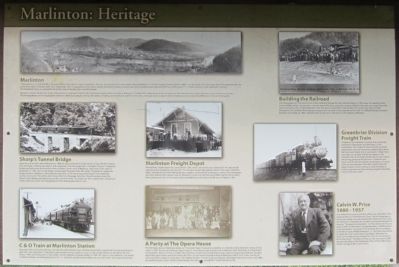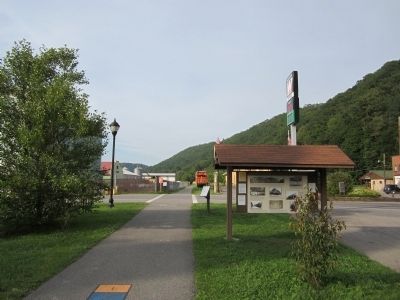Marlinton in Pocahontas County, West Virginia — The American South (Appalachia)
Marlinton: Heritage
Marlinton
“There ain’t no G in MARLINTON!”…so wrote Andrew Price, the first mayor of Marlinton. The town gets its name from Jacob Marlin who arrived here in 1749 with Stephen Sewell and built a cabin near the mouth off the Greenbrier River. This established the site as the first English settlement west of the Alleghenies. After a disagreement over religion, Sewell moved into a hollow sycamore tree, and Col. Andrew Lewis discovered the two on this spot in 1751 while surveying for the Greenbrier Company.
Marlinton remains the business center of Pocahontas County and is home to the Pocahontas County Historical Society and Museum. The McClintic Library serves as the home base for the Award-winning Pocahontas County Free Libraries and houses The Heritage Room and the Appalachian Collection. Marlinton’s people continue the tradition of “rolling out the welcome mat” for visitors who come year round to explore their family history and to enjoy the wild beauty of the surrounding area.
Sharp’s Tunnel Bridge
Upon the arrival of the train in Marlinton in 1900, the push continued to finish the line to Cass. The West Virginia Pulp and Paper Company was eager to ship pulpwood to the new paper mill in Covington, Virginia. A temporary bridge was built across the Greenbrier River at Sharp’s Tunnel north of Marlinton. High water on the night off November 25, 1900, took out the bridge and damaged the grade above the tunnel. The girders to replace the bridge arrived in Marlinton in December, but had come up the line wrong end foremost. A wye track was quickly constructed. The girders were maneuvered into the proper direction. Once the girders arrived, the Sharps Tunnel Bridge was ready for use by the end of the week. On January 22, 1901, a special train consisting of three private cars carried the Chesapeake and Ohio Railway executives to Cass.
C&0 Train at Marlinton Station
Passenger trains during the early days had very few miles between stops. Existing communities coupled with the new sawmill towns gave rise to the saying that “a train had to back up after leaving a station in order to have enough distance to whistle for the next station.” With the development of the lumber industry, ridership increased rapidly. In 1906-1907 trains on the Greenbrier Line carried 139,848 passengers generating revenue of $93,147. Marlinton was the busiest station that year with 24,941 riders boarding the train.
Marlinton Freight Depot
The Marlinton freight depot was constructed in 1905. Once a community was connected to the national rail network, almost everything came by train. This included the everyday material needs of the Upper Greenbrier Valley. Carloads of coal, food, retail goods, farm supplies and household furnishings, as well as mail, newspapers and items ordered from catalogs were all delivered to by rail. Even the first automobiles and the fuel to power them came by rail. One of the busiest stations was Marlinton with close to 50,000 tons of freight in 1907.
A Party at The Opera House
The first Opera House in Marlinton, known as “The Grand,” began showcasing vaudeville acts, dramatic productions and moving picture shows in 1907. The second and larger Opera House, on Third Avenue, towers above other buildings in town reminding us of the impact of the railroad. Built in 1910 by J.G. Tilton, the three-story concrete structure boasted a large stage and wrap-around balcony. The glory days of this grand facility were short lived as Mr. Tilton ran into financial trouble and the building was sold in 1914. It was used for car sales and lumber storage for many years. The building has been restored by the local Historic Landmarks Commission, and is used today as a performing arts center. Thanks to Ruth Morgan and others who brought this “Grand” hall back to life.
Building the Railroad
The Chesapeake and Ohio construction of the Greenbrier Railway through Marlinton began in 1899 along the Greenbrier River south of Stillhouse Run. Construction crews are reported to have used mules, wagons, and tents that were army surplus from the Spanish-American War. It is estimated that 1,500 men were at work within a few months. The construction train pictured belonged to the Greenbrier River Railroad Company and was used to haul materials for the work. The official “first train” arrived in Marlinton on October 26, 1900. The entire town turned out in their finery for the daylong celebration.
Greenbrier Division Freight Train
Freights on the Greenbrier Line were most commonly powered by Chesapeake and Ohio Class G 2-8-0 locomotives. The number of trains and their schedules depended on the level of business available. Many times the trains were freight only, no passengers. Freight trains were often run as “extra” and did not appear on the timetable. Part of the freight hauled was the bark used in the tanning process at the tanneries in Marlinton and Frank. Even though the sawmills would begin to close by 1910, the Cass operation of the West Virginia Pulp and Paper Company would continue to keep trainloads of lumber, pulpwood and slabs moving along the Greenbrier Line into the early 1920’s.
Calvin W. Price
1880-1957
One of Marlinton’s most prominent citizens was Calvin Wells Price, longtime Editor of The Pocahontas Times. The first newspaper in the county and the only one in publication today, the Times holds the distinction of being the last handset commercial newspaper in America. “The typical country editor,” Cal Price was known far and wide for both his “Field Notes” and panther tales. A leading figure in the conservation movement, Price served as the first president of the West Virginia Wildlife Federation. In 1954, three years before his death, the State Conservation Commission dedicated The Calvin W. Price State Forest, an honor for which he proclaimed to be “sinfully proud.” The Babcock Press and old type cases are displayed in the office of The Pocahontas Times, silently reflecting to visitors “The Age of the Country Press.”
Topics. This historical marker is listed in these topic lists: Railroads & Streetcars • Settlements & Settlers. A significant historical year for this entry is 1749.
Location. 38° 13.346′ N, 80° 5.591′ W. Marker is in Marlinton, West Virginia, in Pocahontas County. Marker can be reached from the intersection of 8th Street (West Virginia Route 39) and 4th Avenue. Located on the Greenbrier River Trail. Touch for map. Marker is in this post office area: Marlinton WV 24954, United States of America. Touch for directions.
Other nearby markers. At least 8 other markers are within 5 miles of this marker, measured as the crow flies. Greenbrier Covered Bridge (approx. 0.2 miles away); Marlinton (approx. 0.4 miles away); Welcome to Pocahontas County (approx. 0.4 miles away); Frank and Anna Hunter House (approx. 0.4 miles away); Natural History and Heritage (approx. 3 miles away); Edray (approx. 3.3 miles away); Big Lime (approx. 3.7 miles away); Huntersville Jail / Presbyterian Church (approx. 4.7 miles away). Touch for a list and map of all markers in Marlinton.
Credits. This page was last revised on August 23, 2020. It was originally submitted on August 12, 2012, by Bernard Fisher of Richmond, Virginia. This page has been viewed 849 times since then and 35 times this year. Last updated on August 21, 2020, by Carl Gordon Moore Jr. of North East, Maryland. Photos: 1, 2. submitted on August 12, 2012, by Bernard Fisher of Richmond, Virginia.

